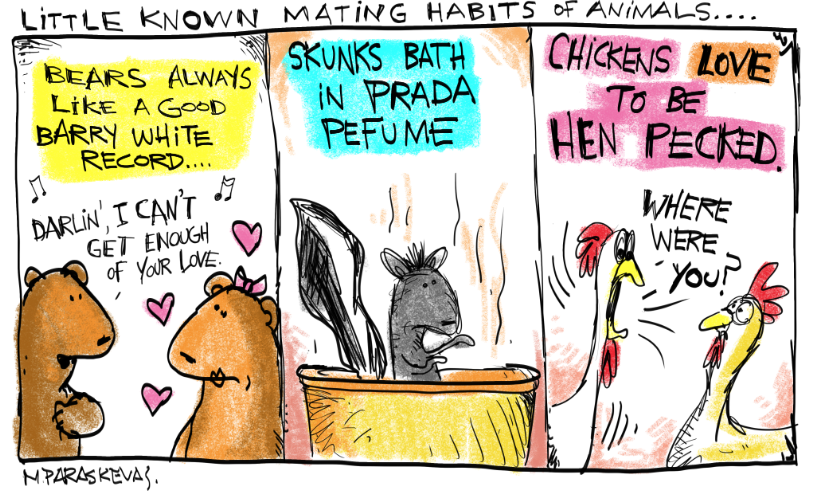Understanding Sex: Mating Habits of Animals, Bugs and Humans Revealed

Last week it was announced that a researcher, Todd Gardner, at the Long Island Aquarium in Riverhead had, for the first time, managed to get a particular kind of fish to breed in captivity. The fish, which is goldfish sized, is called liopropoma reef basslet and the announcement of this is big news for fish breeders. This is an extremely beautiful little fish, more commonly known as a Swiss Guard, and it is a rare and expensive thing to own, which until now could only be found in the wild. This changes things dramatically.
Gardner has not yet revealed the exact circumstances on how he was been able to get them to breed. The females lay the larvae in long string-like extensions from the top of their backs. The males are very finicky about covering them with spawn and, according to Gardner, went on strike entirely during one six month period when he was working on this problem. However, he says, he tinkered with the size and shape of the tank they were in, with microbe control and with egg handling, and with each change, he came closer and closer to getting the fish into the actual act and then getting the babies to be born and survive. At this point, the babies are now 65 days old and thriving. And so, he has felt confident enough to announce his success, which to coin a pun, is now making big waves in the fish world. [expand]
Gardner’s study is one of a whole heap of scientific studies involving sexual activity among animals that are underway at this moment. It is at a level not seen before, in my opinion, and why there is such a focus on sex in labs just now is anybody’s guess. There are even studies coming out about the human sex act. Maybe, with social networking, privacy is out the window and the most intimate acts are just no big deal—but worth examining in detail.
At the Bronx Zoo a month ago, keepers there succeeded in breeding a male and female okapi for the first time in captivity. There’s a little baby okapi running around now that is the pride of that establishment.
Okapis, which look like a giraffe in the front and a zebra in the back, are antelope-like creatures of about 900 pounds that are on the endangered list because of their proclivity to not breed. You can put a male and female together. What they do is turn tail and run away from one another. It’s an appalling situation.
Okapis are afraid of everybody. They are prey, they know it, and their solution to this problem has been to get themselves out somewhere to where they can entirely be alone. Until now, it’s been unknown how they ever get around to liking one another in order to make more Okapi. No one had ever seen them mate, of course, but it was assumed it took place with one mounting the other, which, as it turned out, is exactly how it was done.
What did the zookeepers do to make this happen? An article in The New York Times described it. The zookeepers were very forthcoming in the answer. Patience they said. Incredible patience. Two Okapis were put in two adjacent enclosures. They could not see one another, but they could hear one another. Whenever either of them made a sound, the other would run to the far end of his or her enclosure. And that would make the first do the same.
After about a month of this, the zookeepers opened the door between the two enclosures just a crack. Now the Okapis could sniff the air and smell what the other was like. After a month of this, they opened the door enough so they could see each other. You see where this is going. And they did it.
In another article in The New York Times there was a story about the difficulty that scientists have in studying how dragonflies mate. They can see that the male touches down on the top of the female and they connect. And they stay that way for several hours. After that, the female lays fertilized eggs. What they do during those hours, though, is baffling to scientists not because they can’t see the two together, they CAN see the two together. But the fact is that both the males and females have an astonishing variety of sexual organs that hook up, including grabbers, corkscrews, pinchers, things that rub or saw, all sorts of other things. What does what to what? And when?
The Times interviewed an entomologist named Michael L. May who is making progress in this area and is very proud of himself. He has been breeding dragonflies. And now he has added a twist, if you will. He freezes the dragonflies in the act. Wait till you read how he does this. He freezes the first couple just one minute after they couple up. Then he dissects them to see what is going on. The next couple gets to have sex for two minutes before this guy freezes them. And the next couple gets three minutes. In this way, he has been able to begin to document what goes on during the two-hour period exactly, presuming—and I guess he can prove this—that each couple does it in the same way and in the same order of things, so he can bring it on home. That is his goal.
I don’t know about you, but this gives me goose bumps.
Now come the studies on humans. The first was done at Rutgers last month, the results of which were revealed last week.
The researchers wanted to see how the brain would light up when a human has an orgasm. They figured the moment of truth would light up the pleasurable parts of the brain and they were right about that. Presumably, taking a video of the brain before, during and after orgasm would contribute to the advancement of science. I suppose it would.
They got two volunteers for the study. And this is the interesting part. The women brought themselves to orgasm themselves, manually, in a lab, while electrodes attached to their heads measured what was going on with their brains. Both said afterwards that beforehand they thought it would be very difficult to bring themselves to orgasm in these circumstances, but when they got going, they found it quite easy. The video of their brains is available on YouTube. I have seen it (accompanied by Katy Perry’s song “Firework.”), and I can’t make head or tail of it.
Finally, there is this.
Scientists at a university in the Philippines did a study of testosterone levels in 600 men in Cebu Province over a five-year period. They tested them first at the age of 21 when they were single and then tested them again five years later when they were fathers.
What they found was that fatherhood caused the levels of testosterone in these men to drop substantially. Apparently, what had been aggressive, sexually distracted men—driven by testosterone—became gentler, more sensitive men when confronted with a wife and children. I am not making this up.
The study was co-authored by Lee Gettler, who is an anthropologist at Northwestern University. The results of the study appear in the current issue of the Proceedings of the National Academy of Sciences.
No conclusions were drawn from the study. It was just the facts. You can interpret this any way you wish.



